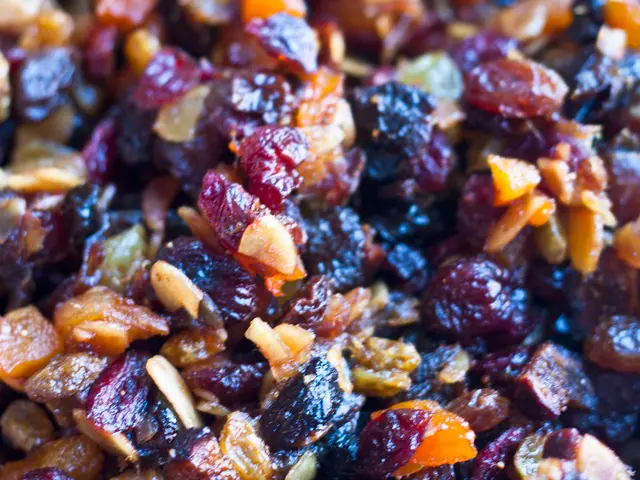Preparing Fried Food: Essential Tools, Ingredients, Breading, and Techniques
Ain't nothing quite as tasty as some well-fried grub, especially when you're grilling up some crispy fries, doughnuts, samosas, and rangoon. But not all fried food is made equal. Here's your guide to making scrumptious, lip-smackin' fried food like a boss.
Deep Frying Essentials
To become a master of frying, you'll need the right equipment, ingredients, technique, and a gang of hungry friends to help you down that deliciousness. Pay particular attention to these key points: your frying oil, having enough room to cook safely, and the correct methods to make it palate-pleasing.
Essential Tools for Deep Frying
To fry right, you'll need:
- the right oil
- a big, deep pot
- a trusty thermometer
- a spider (big metal strainer) or a slotted spoon
A larger pot means more oil required. A candy thermometer that clips onto the side of the pot is an excellent addition, as it helps you keep tabs on the temperature without burning yourself during the process.
A large pasta pot or even the smallest saucepan can whip up some scrumptious sweet or savory fritters if that's all you've got. Just make sure you've got enough space for whatever you're frying so you can work in batches when necessary.
The Top Oils for Deep Frying
Resist the urge to go all healthy on your deep frying process by using everybody's go-to healthy fat—extra virgin olive oil. Instead, opt for oils with neutral flavors and high smoke points.
You'll need enough oil to fill your pot a third of the way, accounting for displacement once you put your tasty delights in for frying. Leave enough room leftover so that the oil doesn't boil over the edge.
peanut oil and soybean oil
The USDA shares these approximate smoke points for popular oils, so you can see at a glance which are best:
| | || --- | --- || Peanut oil and soybean oil | 450°F (232°C) || Grapeseed oil | 445°F (229°C) || Canola oil | 435°F (224°C) || Corn oil, olive oil, sesame seed oil, and sunflower oil | 410°F (210°C) |
450°F (232°C)
The Coating: Bread and Batter
Almost anything can be deep-fried without a coating, but lean or skinless proteins fare better with some assistance. So, to fry like a pro, you've got to know your coatings.
Batters typically consist of flour, a liquid (like water), and a binder (eggs, baking powder). Start with a dry layer of flour, then a binding layer of beaten eggs, and finish with a more textured layer like breadcrumbs, cracker crumbs, or other yummy crunchy stuff. More texture means more crunchy edges.
Take a look at these popular coatings for your crispy treats:
grapeseed oil
- a simple flour and water batter
- Panko breadcrumbs (or regular breadcrumbs)
Pat your foodstuffs dry with a paper towel before frying for optimal crackle. Don't forget to season your batter layers for a delicious flavor throughout.
445°F (229°C)
Pro tip: Keep one hand for moving pieces from dry ingredients to wet, and the other for handling the breaded items to keep one hand clean and functional.
Deep Frying Methods for Maximum Sizzle
To deep fry like a champion, follow these pointers:
- Add oil at room temperature into a cold pan, then heat over medium-high heat.
- Monitor progress using your handy thermometer to hit the desired temperature.
- Ensure your items make a sizzling racket upon entering the oil. Insufficient heat results in a gooey, greasy mess, while too-hot oil burns the outside before the inside is cooked.
canola oil
Without a thermometer, deep frying chicken is tricky. Aim for extra crispy results—with a thermometer it's much easier.
When you're done cooking, put the oil off any heat, allow it to cool, and refrigerate any leftovers within 2 hours. The USDA recommends filtering and storing any leftover oil for up to 3 months. Strain and refrigerate it, and store it sealed for up to 3 months. If it looks or smells off, chuck it.
435°F (224°C)
What You Can Deep-Fry At Home
Want to learn how to fry food for any occasion? Looking to push the boundaries of your culinary creativity? Try these tasty ideas:
- French fries (of course)
- Corn dogs
- Veggie tempura (like cauliflower)
- Samosas
- Fried plantains
- Fried pickles
- Churros
- Doughnuts
Maybe start off with simple wings or zucchini chips, but dream big—deep-fried grilled cheese is the ultimate goal.
corn, olive, sesame seed, and sunflower oils
Alternatives to Deep Frying
Worried about your arteries? Need something a little lighter? Consider pan-frying, sautéing, or air frying—all great alternatives to deep frying that still offer a crispy crunch.
410°F (210°C)
If you're going Air Fryer-style, take a peek at these mouth-watering recipes for party treats, the top 25 air-fried recipes, the best air fryer recipes for fall, and even some keto recipes.
The Takeaway
When it's time to impress your friends with some finger-lickin' good fried food (for any occasion, from a birthday to the Oscars), a big pot and some neutral oil are all you need. Master the techniques, and you can create signature recipes with new spices, coatings, and sauces to impress them all. Let your culinary creativity reign! 🤘
- To achieve delectable fried food, you'll need the right oil, a deep pot, a thermometer, and a strainer or spoon.
- It's crucial to use oils with neutral flavors and high smoke points, such as peanut oil or soybean oil, instead of extra virgin olive oil for deep frying.
- With the correct coating, learned techniques, and a bit of spice, you can whip up scrumptious samosas, fries, and even fried plantains or churros at home.
- If you'd like to avoid deep frying, consider alternatives like pan-frying, sautéing, or air frying, which provide a similar crunch while being lighter options for those health-conscious food enthusiasts.




